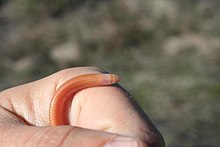| Typhlosaurus | |
|---|---|
 | |
| Typhlosaurus caecus | |
| Scientific classification | |
| Domain: | Eukaryota |
| Kingdom: | Animalia |
| Phylum: | Chordata |
| Class: | Reptilia |
| Order: | Squamata |
| Family: | Scincidae |
| Subfamily: | Acontinae |
| Genus: | Typhlosaurus Wiegmann, 1834 |
Typhlosaurus is a genus of African lizards, one of a number of genera of limbless lizards in the skink family (Scincidae). In 2010 this group was revised, and most species formerly attributed to Typhlosaurus were placed in the genus Acontias . [1] As of 2025 the definition of Typhlosaurus includes five attenuate body legless lizards from southwestern Africa (South Africa, Namibia, Botswana, and Angola). This is the sister genus to Acontias, which together form the well supported Afrotropical subfamily Acontinae. [1]